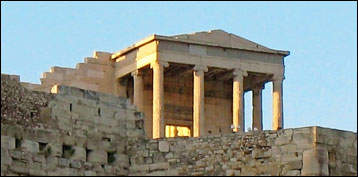



Acropolis
page 3

A few more
Acropolis
tips and insights
 Time has been unking
Time has been unking
The structure has suffered through the centuries.
 Explosion
Explosion
In 1687 (over 2,000 years after the Acropolis was built), a stray cannon shell blew up ammunition being stored inside the Parthenon. The explosion permanently collapsed the roof and seriously damaged the columned walls.
 Elgin Marbles
Elgin Marbles
In the early 1800s, priceless marbles (now called the Elgin Marbles) were transferred without Greek approval to the British Museum in London. The Greek government has been demanding their return, without success.
 Scaffolding
Scaffolding
When I first visited the Parthenon in 1966, it had no scaffolding. Unfortunately, it now bears that visual distraction because of a lengthy reconstruction project.
 Air polution
Air polution
It is badly eroding the precious historic buildings.
 Name
Name
Acropolis means "high city", referring to a hilltop location on a mammoth, steep-sided rock outcropping crowned by a complex of temples and other monumental buildings.
 More than one Acropolis
More than one Acropolis
Some communities in Greece have an acropolis, too. The best known of those is on the Greek Island Lindos. However, the one in Athens is so famous that when you say "Acropolis" by itself, most people assume you are talking about the Athenian version.
 Acropolis Museum
Acropolis Museum
You can see original and replicas of the Acropolis' statues and friezes in the new Acropolis Museum located down the hill.
Learn More
Know my other
Greece tips and insights
Greece wonders - Top 10 rankings
Greece wonder map
Basic Greek phrases for travelers
Greek cuisine
Photo by Jon Corelis - CC BY-SA 3.0


World's Top 100 Wonders
World's Top 1000 Wonders
Site map
My credentials
About my website and criteria
Reader testimonials




